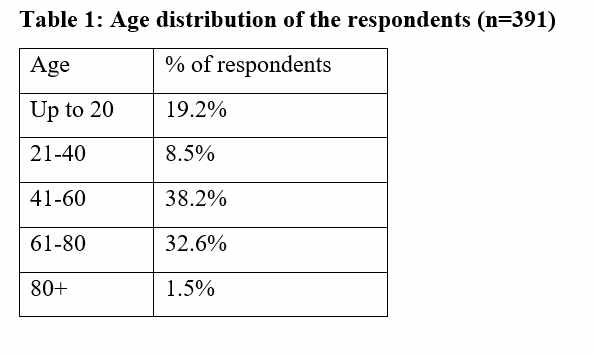Think about your most personal ritualistic event–walking your dog, grocery shopping, or a weekly meet-up with your friends. Most likely, it takes place in the same place, close to home, with the same people, and at a certain frequency. Rituals occur also on the social level; for example, Sunday Mass, birthday parties, and sports competitions.
Ritualistic events are characterized by two dimensions: continuity and repetition, and emotional engagement. In this blog, we discuss the links between rituals and data science, arguing that thanks to these two characteristics, machine learning algorithms can model rituals relatively easily. If and when needed, this model can then predict how a given ritual will continue in case an unexpected situation halts its ritualistic pattern.
We illustrate our claim using the case of the Israeli 2023 social protest, which had taken place for nine months, from January 2023 until October 7th, 2023, when the State of Israel experienced its worst terror attack since its establishment in 1948, and reality in Israel changed dramatically. That Saturday night, October 7th, was supposed to be the 40th week of the social protest. Due to the extreme events of that morning and the war that followed, the demonstrations were called off and have not been renewed at the same volume and in the same ways since. As it turns out, in the new Israeli reality, the ritualistic characteristics of the protest did not stop existing; rather, the protest transformed into a new ritual that was manifested by a large civic social movement, maintaining the two ritualist characteristics mentioned above.
In this blog, we argue, therefore, that the ritualistic character of the protest does not only explain its success but also enables, from a data science perspective, to predict the new form it took. The adoption of the data science perspective to explain the new form of the protest makes sense considering the properties of rituals and machine learning algorithms. As a ritual, the protest exhibits a pattern of behavior, which is expressed by a vast amount of similar data. The machine learning algorithm identifies (relatively easily thanks to the repetitive nature of the ritual) the critical features and patterns of that ritual and constructs a model that predicts new instances of the ritual that were not seen before.
Data collection for protest characterization
According to the anthropological tradition, ritualistic behavior has two dimensions: the continuity of the act, and the symbols that hold meaning for the participants and lead to their emotional engagement (Turner, 1969). For scholars seeking to explain the persistence of protest, the task is, therefore, to characterize the continuity of the action and to trace the meaning-making processes in the protest events themselves.
Thus, as civilians as well as scientists, our repeated participation in the protests enabled us to systematically and continuously observe the events and document them. Based on our insights, we then designed a questionnaire (in Hebrew) that was distributed through various relevant WhatsApp groups in Israel and abroad, where demonstrations in support of Israel’s democracy also took place. The questionnaire addressed the habits of protest participants and included both closed- and open-ended questions. The closed-ended questions referred to places, time, and frequencies and helped characterize the respondents and the repetitive characteristics of the ritual. The open-ended questions addressed personal behaviors and feelings. We received 391 responses.
It seems that the respondents more or less represent the protester population in terms of age (see Table 1), gender, and protest location. The gender distribution among respondents was 59.4% females, 39.8% males and 0.8% others. Of the locations most frequently listed by the respondents, we mention the three largest cities in Israel: Tel Aviv (44%), Jerusalem (27.9%), and Haifa (23.2%) (respondents could select more than one location), and abroad, where 15.6% of the respondents resided.
The ritualistic spirit of the Israeli social protest
We demonstrate the ritualistic characteristics of the protest using the data we collected.
- Continuity: frequency, location, fellow protesters
The protest continued for a very long time (January 2023 – October 7, 2023) and took place in 150 locations; it is estimated that about 4% of Israel’s population took part at one time or another. This percentage is important since, based on research by Chenoweth and Stephan (2011), once 3.5% of the population of a state participates in a sustained protest, its success is guaranteed. Most of the respondents (91.3%) participated in the weekend demonstrations. About half of them (50.7%) participated once a week, and close to a quarter (23.8%) participated at least twice a week in some activity of the protest. Only one-quarter (25.5%) participated in the protest activities less than once a week. In terms of locations, 63.4% participated in demonstrations that took place in their area of residence, and 28.4% participated in protests both near their homes and elsewhere. The 150 demonstration locations spanning the entire country allowed people to maintain the ritual since a close location was always accessible requiring neither a long commute nor any expenses. [See Barberá et al., (2015) for a discussion of the critical role of the periphery in the growth of social protests.]
We asked the respondents to describe the specific location they usually stand in during the demonstration itself: over one-third (36.3%) replied that they stand in the same place and about the same percent (38.5%) answered that they sometimes stand in the same place, and sometimes not. When asked who they go to the protests with, 77.7% answered that they often go with the same people (family or friends). Indeed, going to the same place once a week, at the same time (Saturday night), with the same people, and standing in the same spot, is nothing but a ritual.
B. Symbolism: vocal elements, items, emotional engagement
Rituals frequently incorporate symbols that hold meaning for the participants. In our case, although the protest was considered an anti-government protest, the protestors adopted national symbols that highlighted the emotional connections of the protesters to the protest messages.
We asked several questions regarding the different parts of the demonstration, items that protesters felt it was important for them to bring to the demonstrations, and emotional engagement:
- Which part of the demonstration is the most meaningful for you?
For 29.9% of the responders, the speeches were the most significant part, and for 23.9% it was the intermediate chants, whistles and songs; for 14.9% it was the march to the place of the demonstration; and for 11.8% it was the national anthem.
2. Important items to bring to the demonstrations:
An Israeli flag was the item most frequently mentioned as the most important thing to bring to the demonstration. Other objects were placards, shirts of one of the 150 organizations and associations that took part in the protest, and other people (!), as an “item”. The “other people” answer is interesting, as it further highlights the spirit of the ritual, which in many cases takes place as a communal activity. More abstract objects mentioned were (positive) energy and “myself,” expressed in terms such as my voice, my presence, my participation, and my feeling of belonging.
3. Emotional engagement
Emotions displayed by participants in a ritual can allude to the significance of the ritual for them. The emotional engagement expressed in the answers to our questionnaire was apparent. The most common answers to the open-ended question: “What are three feelings you feel when participating in a protest event?” were hope, pride, excitement, and a sense of belonging, as well as concern, anger, anxiety, and sadness. In addition, when asked why, in their opinion, other people participate, many of the respondents suggested fear for the fate of the nation, a feeling that is highly relevant in our explanation of the new form of protest that arose, as presented below.
Conclusions: The new form of the ritualistic protest
On October 7, 2023, the protest changed its form. Its skilled infrastructure was immediately channeled to civil purposes to support the hundreds of thousands of citizens who were influenced by the war. Among these channels and activities we mention the War Room opened to track kidnapped and missing people, the shift in the activities of the Brothers in Arms organization, the Restart-Israel website, which changed its focus from the protest to the civil and judicial aspects of the war, the demonstrations for the release of Israelis kidnapped and held captive by Hamas terrorists in Gaza (e.g., the march to Jerusalem and the Saturday night demonstrations), and many more. This immediate and spontaneous shift is expressed in Hazzan’s declaration “If there were no protest…“:
If there were no protest, we wouldn’t have reconnected to our flag and to our anthem
If there were no protest, we wouldn’t know how to fight for a dream
If there were no protest, we wouldn’t know what Kaplan is and come support the families of the kidnapped
If there were no protest, who would welcome the families of the kidnapped at the UN?
If there were no protest, there wouldn’t have been a technological infrastructure ready for the immediate launch of the civilian War Room
From the ritual perspective, this shift can be explained by the symbols that hold meaning for the participants and lead to their emotional engagement, reflecting the motivation, active on-going participation, and the general feeling of belonging to a large community which they care about and wish to protect.
From a data science perspective, had we taken this perspective, this shift could have been explained by the fact that thanks to the massive amount of what we call “ritual data” collected over the 40 weeks of the protest and demonstrations, first, a predictive machine learning algorithm could have easily modelled the ritual, and second, using this model, a new instance of the protest, namely a large civic social movement that befits the new situation in Israel, could have been predicted.
Orit Hazzan is a professor at the Technion’s Department of Education in Science and Technology. Her research focuses on computer science, software engineering, and data science education. For additional details, see https://orithazzan.net.technion.ac.il/. Avital Binah-Pollak is a socio-cultural anthropologist at the Technion’s Department of Humanities and Arts. Her research focuses on education, creativity, and mobility in contemporary China. For additional details, see https://humanities.technion.ac.il/en/dr-avital-binah-pollak/





Join the Discussion (0)
Become a Member or Sign In to Post a Comment